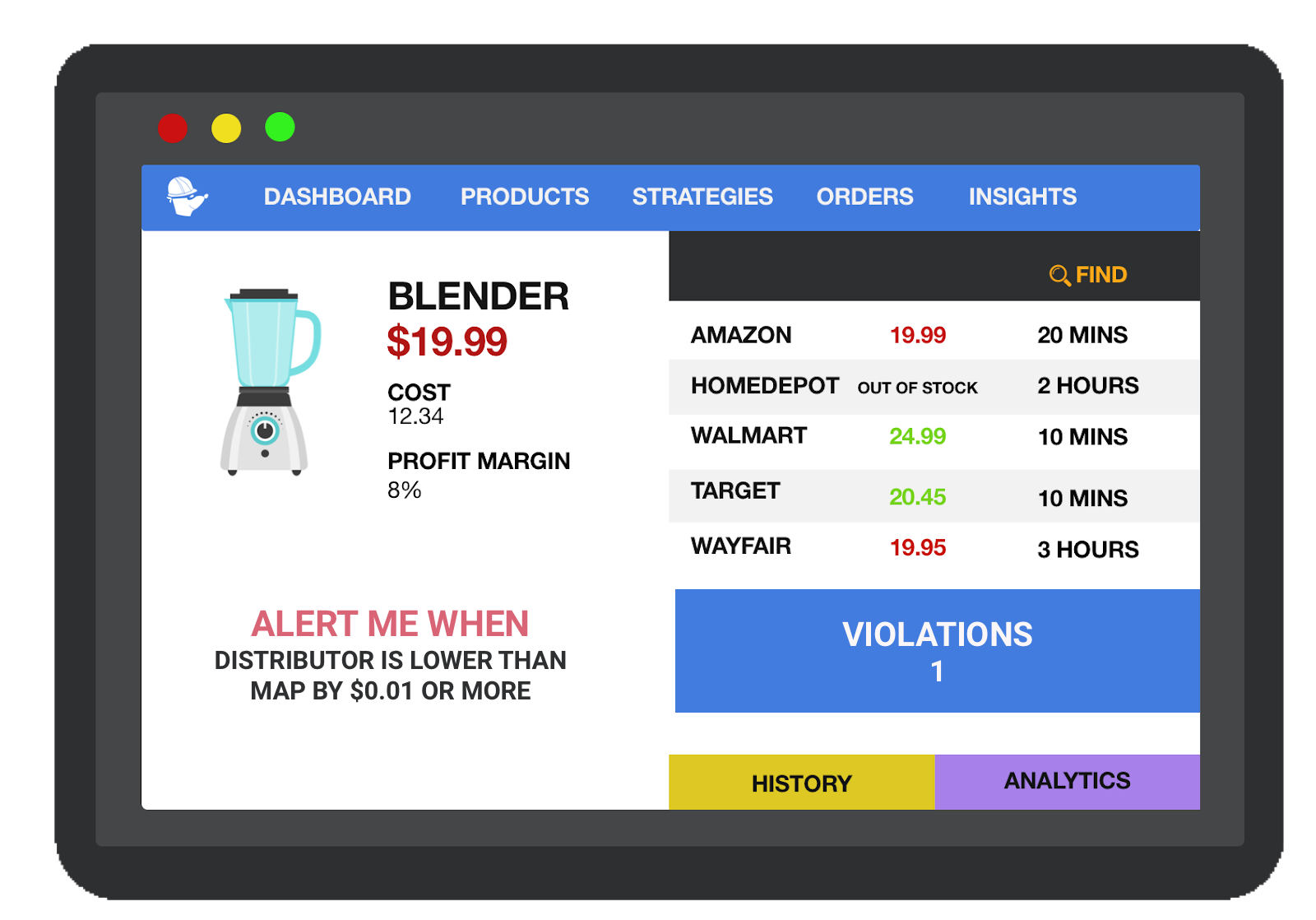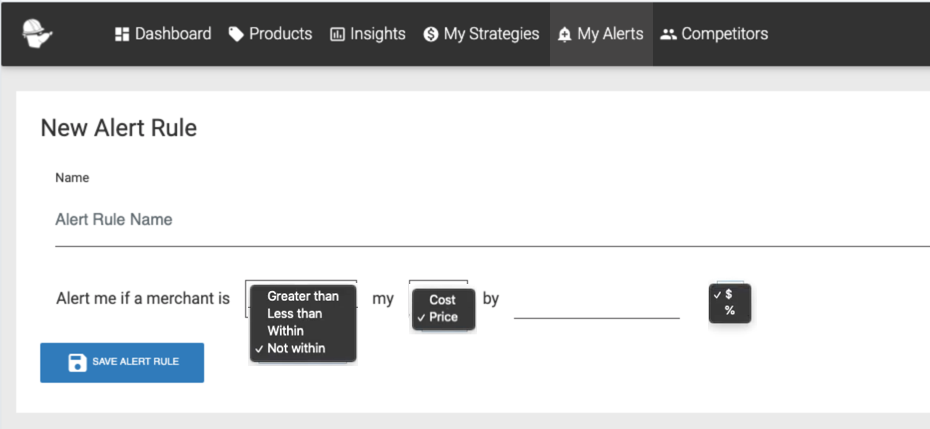How To Automate MAP Monitoring - Minimum Advertised Price

Enforcing minimum advertised prices (MAP) in today's competitive marketplaces such as Walmart, Google Shopping, eBay, and Amazon isn't easy.
You need a plan to ensure everyone knows about your Minimum Advertised Price Policies, and you need a way to enforce them. Let's take a closer look:
What is a Minimum Advertised Price?

A MAP price is a minimum advertised price amount that resellers, manufacturers, suppliers, brands, and distributors agree not to advertise below publicly. MAP pricing or MAP monitoring is designed to protect the manufacturer from loss of profit while regulating competition between retailers and helping the consumer make purchases from trusted brands.
For example, if you set a MAP price of $50 for a product, all of your resellers and distributors are obligated to advertise this product at $50 or more.
The Minimum Advertised Price Agreement is binding, just like any other contract signed by both parties. However, it is often taken lightly and therefore violated. If the manufacturer learns of infringement, this is a breach of contract, which means the manufacturer can terminate the business relationship with the retailers that violate their MAP.
It's important to note that in the USA, as of 2007, the Supreme Court decided to provide greater legal protection for manufacturers with minimum price policies.
Why do the Minimum Advertised Price (MAP) agreements exist?

Because eCommerce is growing faster than ever, even more so due to COVID-19, Minimum Advertised Price Policies or MAP Monitoring matter more than ever. They help preserve e-commerce as a viable business model with profitable margins.
MAP agreements help:
- promote fair competition across all distribution channels
- maintain brand identity and value
- prevents the "Best Price" self-perpetuating feedback loop
- smaller sellers compete with large retailers
- prevent underpricing and races to the bottom
- protect seller margins and profits
"Consistent pricing sends a clear message about a brand's value to buyers."
- Tara Johnson, Tinuiti, SEO Research and Marketing for Amazon and Google
One of the most successful MAP stories includes Ray-Ban, who is the parent company of Luxottica. A few years ago, they decided to introduce a MAP policy that helped them discover and seize over 4.8 million counterfeit products and close 17,000 unauthorized retailers stores. All of this enabled them to maintain over 9,200 retail stores successfully, double that amount in authorized retailers and over 9493 billion in sales last year.
So if Minimum Advertised Pricing (MAP) benefits everyone,
Why and how do Retailers violate their agreements?
"Approximately 40% of retailers never violate MAP, but 20% violate it all of the time. On average, violations are 14.5% - 17% below MAP."
- Kate Harrison, Forbes, (How To Protect Your Company's Minimum Advertised Price (MAP) Online)
Sometimes violations occur by accident when a discount is offered across the full cart, and some items within the cart have MAP agreements. Other times it is more deliberate. When one retailer chooses to violate the agreement, it causes a domino effect. Many retailers follow in an attempt to undercut the competition, while the price continuously falls until retailers hit their minimum price.
Most common violations include:
- Bundles: Buy one, get one free
- Click to see price (our offer is lower than the minimum advertised price)
- Add to cart to see price (our offer is lower than the minimum advertised price)
- Discount code offers
Violation most commonly occurs:
- on reseller marketplaces like Walmart, Google Shopping, eBay, and Amazon
- when a MAP agreement is about to expire
Most Common Violators:
- from unauthorized retailers with no MAP agreement
- retailers with a small catalog
- retailers that charge for shipping (charge more for shipping, in turn, less for the product)
Considering all of the above, MAP monitoring isn't straightforward, so..
How do I detect Minimum Advertised Price (MAP) violators and protect against them? How do I automate MAP monitoring?

Manually MAP monitoring and tracking your resellers and distributor's prices takes a lot of time. Manually tracking your competitor's prices takes about 30-45 seconds to check someone's site considering finding the correct product and load times. The same goes for monitoring your retailers and checking to see if they violate their MAP agreement. Manually tracking could easily result in more than 30-40 hours of work, and much more for more extensive catalogs. Even if you were willing to allocate someone to do this job full-time, it is now prone to human error.
As we have learned through automated price tracking for competitors, prices change constantly. For example, Amazon changes over 2 Million prices daily. Imagine trying to keep up with these changes manually.
The solution is automation. Using a smart AI-driven software solution helps you monitor your reseller's prices and notify you of any violations.
PriceMole can do just this for you.

PriceMole can help you monitor any site on the web. You can add all of your resellers and distributors to the software, establish the MAP rule agreements you have in place with them, and let the app monitor the price changes and inform you of any infringements. Additionally, PriceMole can scan the web for new unauthorized retailers, informing you when someone is selling your products without an agreement.
Just like Competitor Price Tracking, Minimum Advertised Price monitoring is now AUTOMATED!
Not only have you eliminated all of the wasted time manually tracking, but you have also removed the possibility of human error, allowing you to focus on building your business with trusted sellers and helping preserve your brand and credibility!
PriceMole MAP monitoring can help you:
- identify unauthorized retailers
- track established retailers
- notify you of violations
- enforce established margins
- save hundreds of hours manually monitoring
- find growth opportunities
How do you handle MAP violators?

First things first, you need to identify all of your brands' MAP violators. Start monitoring MAP Agreements across a range of your products against all of your retailers to identify them.
Second, Contact the retailers who are advertising below the minimum advertised price, and let them know you mean business. They need to know that you are serious and willing to terminate the agreement or even take legal action. Still, it's always best to warn them and give them a chance to fix violations before ending the relationship.
Thirdly, Remind sellers WHY there is a MAP Policy, and that it is essential to respect the agreement for the manufacturer, the reseller, and the consumer.
Lastly and most importantly, CONTINUE TO USE MAP MONITORING ACROSS ALL CHANNELS. Once you have uncovered the violators and warned them, and the MAP pricing agreements are respected, it seems all is well. The question though remains, for how long, and when will the prices start to drift or when will new unauthorized sellers pop up again. Let automation monitor and track prices for you, so you are never caught off guard!
In Conclusion
The most important take away from this article is to be consistent. You can send a clear message about your brand by using automated MAP monitoring and enforcing these agreements when violated. If you consistently monitor and ensure your interests, your reseller's interests, and your consumer's interests are protected, your brand will stand out and let your brand become stronger in the future.
Have any questions, comments, ideas? Think we missed some information about MAP monitoring - Minimum Advertised Pricing? We look forward to hearing from you!
Check out some of our other articles here:
- The 9 Highest Margin Products of 2019
- The Price Strategy - How to implement automated price strategies for competitor price tracking
Want to learn more about Competitor Price Tracking with PriceMole? Learn more on our Website ,, Shopify Facebook, Linkedin, and Twitter.